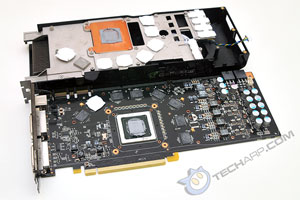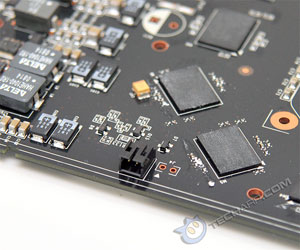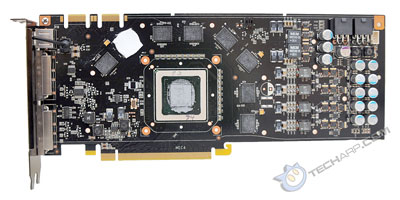Dismantling The Card
We removed the NVIDIA GeForce 9800 GTX's cooler to have a look under it. It wasn't very difficult even though the cooler had a whole lot of screws holding it in place. It was merely a matter of unscrewing all of them and twisting the cooler off.
 |
This is what the card looks like without its cooler or shroud. The GPU is the centerpiece, of course, framed by a coterie of eight GDDR3 SDRAM memory chips. The new 55 nm G92 GPU does look smaller than the 65 nm G92 GPU used in the GeForce 8800 GT. However, it still uses the same package which is pretty large, with a metal shim around the GPU die.
 |
Near the bracket is a LED at the end of a short cable. That LED lights up if you do not attach the two required PCI Express power cables.
 |
The GeForce 9800 GTX+ comes with integrated support for HDMI. It can deliver full HDMI output using a DVI-to-HDMI adaptor as well as the on-board SPDIF audio connector (see second picture above). The SPDIF audio connector is located at the top of the card. It is easy to miss it though, because it's so small.
Graphics Memory
 The GeForce 9800 GTX+ comes with 512 MB of GDDR3 memory.
The GeForce 9800 GTX+ comes with 512 MB of GDDR3 memory.
This reference card used eight Qimonda memory chips, each with a capacity of 512 Mbits. For those who do not already know it, Qimonda is actually Infineon's memory division spun-off as a separate company.
We were not able to read the numbers off the memory chips, so we are not sure what model was used in this card. However, they should be rated for at least a clock speed of 1.1 GHz.
Support Tech ARP!
If you like our work, you can help support out work by visiting our sponsors, participate in the Tech ARP Forums, or even donate to our fund. Any help you can render is greatly appreciated!
<<< Size Comparison, Cooler GPU?, Specifications : Previous Page | Next Page : The Cooler, The Fan >>>







 Add to Reddit
Add to Reddit



